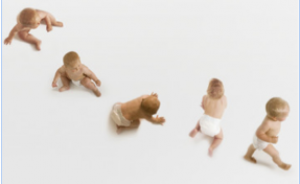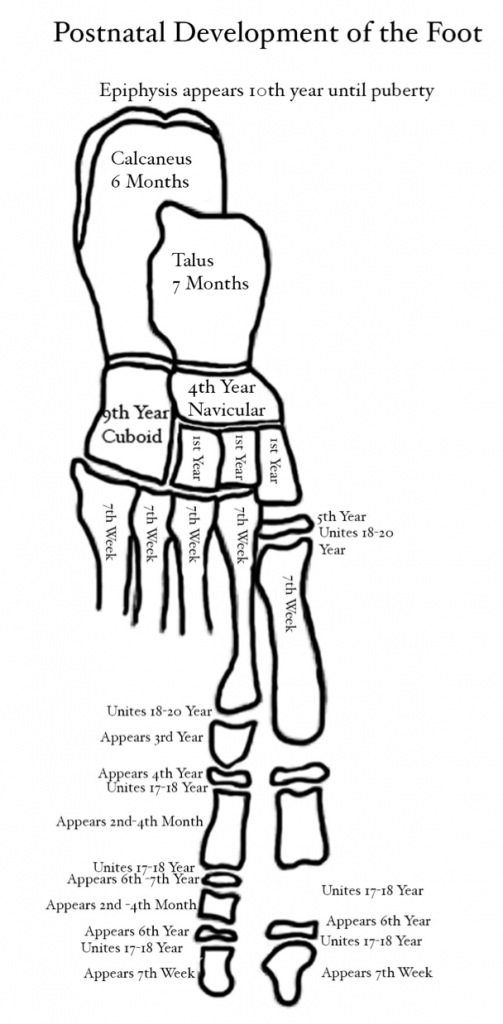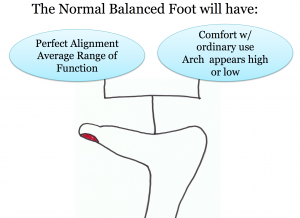 It’s an exhilarating event to watch a baby learn to walk. Seeing a youngster attempt to upright themselves and take their first steps makes the heart sing and usually applauds and ovations prompt the baby to his or her striding success.
It’s an exhilarating event to watch a baby learn to walk. Seeing a youngster attempt to upright themselves and take their first steps makes the heart sing and usually applauds and ovations prompt the baby to his or her striding success.
With each attempt to stand and walk the baby’s feet gain strength and slowly their soft cartilaginous bones begin to ossify (turn into compact bone) enough to be able to hold their weight. Although still fairly soft, once the bones of the feet start to form, then the baby has a foundation on which to stand and walk. This early stage of life is decidedly the time where parameters are set for the future health of baby’s feet–which continues for about 18 to 20 years when the feet have fully matured from 45 bones in each foot to 26.

This image shows the bones of the feet as they develop from the age of 6 months to 20 years old.
So… because of the baby’s soft foot bones, this is the time when the structural health of the feet will be most influenced.
Let’s explore this. Crawling prepares and strengthens the baby’s foot muscles for the agility and power to eventually, help the babe upright. The act of crawling is also an important developmental stage that helps reinforce the maturation of the main arches of the foot. If the babe walks before the muscles of the feet are strong enough (usually one inspired to keep up with an older sibling), the soft bones of their feet may flatten while the arches are in the process of developing because the muscles that cushion the bones of the feet and help to form these arches are unprepared to carry the baby’s weight– and this is what causes the low arch or flat foot. With this in mind, parents should not push the child into walking too soon. It’s really the child who should decide, and then the parent can assist.
And by the way, all babies feet appear flat. The arches of the feet become more visible as the child grows into puberty. Furthermore, there is nothing functionally wrong with having a low arch or a flat foot.

Here are other considerations to be aware of in taking care of baby’s precious feet:
Except from Chapter 15: “Flat Foot or Fallen Arch” from my book Put Your Best Feet Forward:
…Just because they can stand doesn’t mean you need to put shoes on their feet to help this process. This would only be a disservice to the child who is learning to develop balance in the feet alone. Always keep in mind their bones are still soft and impressionable to shoes and socks. Babies who walk barefoot will have a better chance developing a stronger core, leaner muscle mass, and broad shoulders to match the proportion of their base; i.e. their shoulders won’t roll in because the little toes haven’t been scrunched in shoes.
If a child wears shoes before the age of four, the shoes will rob the child of learning to let the feet carry them without the influence of shoes. At this age, shoes will impact the development, shape, and function of the foot and force them to walk in a way that may not be natural to them, and their body will develop while compensation forms their posture.
The late podiatrist, Dr. Simon Wikler, emphasized if you must put shoes on a baby’s feet, they should be no more than a protective covering, such as a moccasin style (completely flexible) that is a little wider in the forefoot, more secure in the heel, and that ties or fastens with Velcro onto the foot. Leather is best because its composition is compatible with our skin. (1961)
Babies need to wiggle their toes which makes them sturdy and able to balance the body when learning to walk, so it’s best to let them be free to do so–including at bed time when children grow the most.
Please share this and read my previous blogs to learn more about keeping your feet strong and agile, and to understand how to learn to walk for better health.
Baby image from Stock images from Dreamstime
Archives
- October 2024
- December 2023
- October 2023
- March 2022
- July 2021
- August 2020
- May 2020
- April 2020
- February 2020
- January 2020
- December 2019
- November 2019
- October 2019
- August 2019
- June 2019
- May 2019
- April 2019
- January 2019
- December 2018
- October 2018
- September 2018
- July 2018
- June 2018
- April 2018
- February 2018
- December 2017
- November 2017
- October 2017
- September 2017
- August 2017
- July 2017
- June 2017
- May 2017
- April 2017
- February 2017


